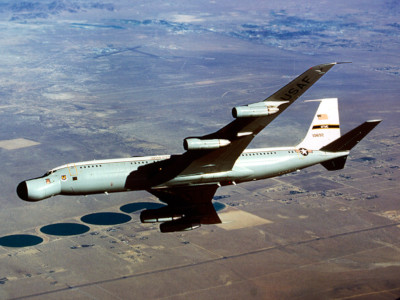
Navy Uses ARIA to Train New Pilots
Flotilla in the Mojave
Navy uses ARIA to train new pilots
June 2000
Desert Wings
By Ray Johnson
Public Affairs
It’s not as if the 7th Fleet has pulled in, but a small Navy presence will be docked here for several months.
Navy instructor pilots are using EC-18B’s from the 452nd Flight Test Squadron to train naval aircrews who will operate E-6B Mercury aircraft. The E-6 provides communication links between national command authorities and U.S. strategic nuclear forces.
Cadre from the Navy’s Fleet Air Reconnaissance Squadron 7, or VQ-7, at Tinker Air Force Base, Okla., rotate here periodically to school student pilots and navigators aboard the EC-18s.
Prior to flying five or six sorties at Edwards, students undergo numerous simulator “rides” at Tinker following initial aircrew training. After returning to Oklahoma, they will make several actual E-6 flights before graduating from the program and joining the fleet to support U.S. Strategic Command at Offut AFB, Neb.
VQ-7 is using 452nd birds because one of its two aging trainers, a TC-18, was grounded after an FAA-mandated inspection. Looking for quick replacements, VQ-7 discovered the 452nd flies aircraft built on the same airframe, a Boeing 707, as their TC-18.
And with the EC-18B Advanced Range Instrumentation Aircraft, or ARIA, not flying as frequently as in the past, “we have a readily available product for the Navy’s immediate need,” said Master Sgt. Dave Niehuas, 452nd FLTS flight engineer superintendent.
This Air Force/Navy collaboration is a “win-win situation all the way around,” said Maj. Charles Hertenstein, 452nd FLTS operations officer.
“The Navy wins,” he explained, “because they can keep their pipeline open for E-6 flight crews. We win because they could possibly augment us during manning shortfalls when our regular line pilots need upgrading to become instructors.”
And while it hasn’t been exercised, there is an option built into a memorandum of agreement that allows VQ-7 members to participate in 452nd missions if needed.
“We have that flexibility,” Hertenstein said.
Prior to Navy pilots flying ARIA, they must receive ground training and a checkout ride. On the flight line, the most obvious difference between an EC-18 and TC-18 is ARIA’s bulbous nose, which houses a seven-foot dish antenna that gathers telemetry data.
“But after taking off, you really don’t notice it,” said Lt. Cmdr. Randy Green, a VQ-7 student pilot.
With everyone wanting this partnership to succeed, an obvious rapport has been established between the two sister-service units, said Lt. Gary Hooyman, a VQ-7 instructor pilot.
No pun intended, but he said, “Right off the boat, we realized that it would be easy to work with the 452nd and that they were here to work with us. We both came to the table with the same attitude of doing whatever it took to make this project work.”
The current agreement between the 452nd and VQ-7 has the Navy employing the ARIAs until October, with a possible year extension if it hasn’t acquired new trainers by then.
The VQ-7 students training here eventually will join a Navy air wing fully integrated on Tinker AFB, carrying out a mission for joint operations. The 16 E-6s they will operate enable the president and the secretary of defense to directly contact submarines, bombers and missile platforms protecting the United States through nuclear deterrence.